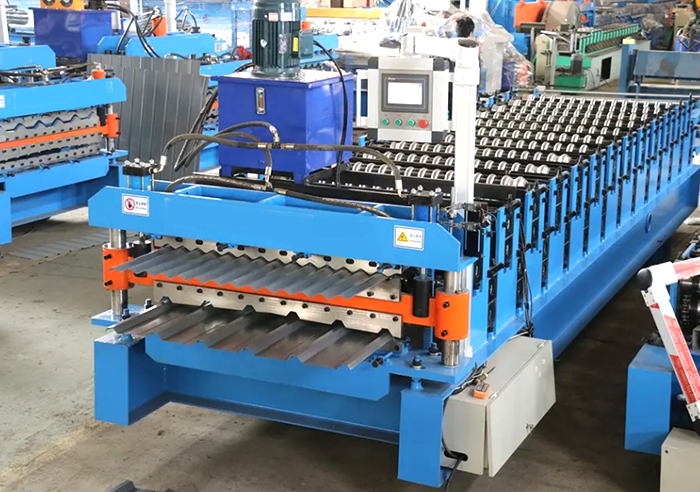corrugated steel panel roll forming machine
The Innovation of Corrugated Steel Panel Roll Forming Machines
In the realm of modern construction and manufacturing, the demand for durable, lightweight, and cost-effective building materials has spurred significant advancements in technology. One such innovation is the corrugated steel panel roll forming machine, a key piece of equipment that has transformed the way corrugated steel panels are produced. This article explores the importance, functionality, and benefits of these machines in the construction industry.
Understanding Corrugated Steel Panels
Corrugated steel panels are widely used in various applications, including roofing, siding, and interior partitions. They are characterized by their wavy, ridged shape, which not only enhances aesthetic appeal but also provides exceptional structural strength. The design of these panels allows for effective water drainage, making them an ideal choice for roofs, while their lightweight nature ensures that they can be easily handled and installed.
What is a Roll Forming Machine?
At the heart of the production of corrugated steel panels is the roll forming machine. This advanced equipment utilizes a continuous bending process to transform flat metal sheets into specified shapes and profiles. The sheets are fed into the machine, where they pass through a series of rollers that gradually shape and bend the metal into a finished product. The precision and consistency achieved through this process ensure that each corrugated panel exhibits uniform dimensions and strength.
The Functionality of Corrugated Steel Panel Roll Forming Machines
Corrugated steel panel roll forming machines are designed for efficiency and speed. They come equipped with features that enhance productivity, streamline operations, and reduce material waste. Key functionalities include
1. Customization Many roll forming machines offer the ability to customize the size and shape of the corrugated panels. This flexibility allows manufacturers to cater to specific project requirements and client preferences.
2. Automated Systems Modern machines often incorporate automation technology that facilitates quick setup, adjustment, and operation. Computer Numerical Control (CNC) systems can optimize the forming process, increasing precision and reducing labor costs.
corrugated steel panel roll forming machine

3. High Production Rates Roll forming machines can produce large quantities of corrugated panels in a short amount of time, significantly boosting output. This capability is crucial for meeting the demands of large-scale construction projects.
4. Durability and Reliability Built to withstand harsh operating conditions, these machines are made from high-quality materials, ensuring longevity and minimal breakdowns. Regular maintenance further enhances their reliability.
Benefits of Using Corrugated Steel Panel Roll Forming Machines
The adoption of corrugated steel panel roll forming machines presents numerous advantages for manufacturers and builders alike
1. Cost Efficiency By optimizing the production process and minimizing waste, these machines help reduce overall manufacturing costs, making corrugated panels more economically viable.
2. Enhanced Quality The precision of roll forming leads to high-quality panels with consistent finishes. This reliability translates into fewer installation issues and long-lasting performance in construction projects.
3. Sustainability The ability to use recycled materials in the production process and the long lifespan of corrugated steel panels contribute to more sustainable building practices.
4. Versatility Beyond roofing and siding, corrugated steel panels are used in a variety of applications, including industrial buildings, warehouses, and agricultural structures. This versatility makes roll forming machines a valuable investment.
Conclusion
Corrugated steel panel roll forming machines are revolutionizing the construction industry by providing an efficient, cost-effective means of producing high-quality building materials. As technology continues to advance, these machines are likely to evolve further, bringing greater efficiency and innovation to the manufacturing process. With their ability to deliver strong, lightweight, and aesthetically pleasing products, corrugated steel panels continue to be a staple in modern architecture and construction. The future of building may very well hinge on the capabilities of these remarkable machines.
-
Roof Panel Machines: Buying Guide, Types, and PricingNewsJul.04, 2025
-
Purlin Machines: Types, Features, and Pricing GuideNewsJul.04, 2025
-
Metal Embossing Machines: Types, Applications, and Buying GuideNewsJul.04, 2025
-
Gutter Machines: Features, Types, and Cost BreakdownNewsJul.04, 2025
-
Cut to Length Line: Overview, Equipment, and Buying GuideNewsJul.04, 2025
-
Auto Stacker: Features, Applications, and Cost BreakdownNewsJul.04, 2025
-
Top Drywall Profile Machine Models for SaleNewsJun.05, 2025








